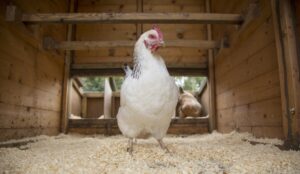The last time I travelled on the London Underground, I had our Labrador, Saffy, with me. Britain is a nation of dog lovers, but I was still surprised by how many strangers cooed over her. It was startling, in fact, compared to my recollections of travelling on the Tube with a baby in a pushchair a few years back. No contest: Saffy got more love.
So the ad I spotted in that Tube carriage, for the dating app Tinder, seemed particularly fitting. It depicted a smiling young couple in psychedelic clothing, with the caption: “Finally Having Kids”. They each rest one hand on a pushchair. In the pushchair is a dog.
If, given my recent experience, Londoners seem more partial to dogs than kids, this may not be the only way in which “fur babies” are on the up. According to last year’s ONS data, half of British women now reach 30 without having kids. And Pets At Home CEO Lyssa McGowen thinks some of these have redirected their caring urges toward pets. “They are taking all that time and energy and attention and putting it into fur babies, especially in urban areas,” she said.
McGowen speculates that this is happening because the classic milestones of adult life — such as getting your own place — seem increasingly out of reach to many, thanks to scarce housing, rising costs and stagnant wages. This feels plausible: in the US, studies show the stated desire for family size has remained consistent even as the birth rate has fallen. And one recent UK-based Rolling Stone investigation quoted many young couples for whom money is indeed the sticking point.
But is that all there is to it? Prospects for Gen Z are not as optimistic as for their Boomer grandparents, but in absolute terms human societies have lived through greater turbulence and gone on having kids. Birth rates remain buoyant, for example, in the Democratic Republic of Congo, which consistently makes the top 10 in the Fragile States Index of most unstable countries. So what else is in the mix?
Liberal feminist Jill Filipovic argues that if more women are opting to have fewer or no kids, it isn’t so much about the financial pinch. Certainly, among dog-walking acquaintances locally, I can think of several childless, younger millennial heterosexual couples who seem, on the face of it, pretty sorted: good jobs, comfortably off, often homeowners, sometimes even working flexibly from home. Ideally situated, in other words, for starting a family. And yet, they have no kids. For some in this situation, the dog is an object of minute, loving observation and care, and plays the central role in conversation that children usually do for young parents. Watching this, my sense is that although for some economics is a factor in choosing between human babies and the fur variety, at least some of the time it’s not just about money. It goes, rather, to the heart of what we think the purpose of life is — and thus what we are.
When I took our Tube-travelling dog for a check-up recently, the vet asked if we were planning to have her spayed. In discussing the pros and cons, the vet suggested one benefit would be that, once neutered, “she can just get on with being a dog”. It stuck in my mind: after all, isn’t the reproductive cycle part of being a dog? In what sense would neutering Saffy make her freer to be a dog? What kind of dogness is actively obstructed by the organismic urge to make more dogs?
If, as McGowen suggests, a great many young adults today are directing their parental instincts toward pets, I suspect a central reason is that we’ve embraced an equivalent understanding of humanness. That is, we’ve come to believe that the preconditions for realising yourself fully — especially in the field of sex and relationships — now actively foreclose becoming a parent, or at least radically reduce parenthood to one not especially appealing option among many. Given the pervasiveness of this message, the surprise shouldn’t be that many young men and women are pouring that caregiving urge into “fur babies”, but that anyone is bucking the trend and still making the human sort.
Fertility really started plummeting with the onset of the sexual revolution. While modernity consistently drives down birth rates, in the UK (with the exception of a wartime blip) the average number of children per woman remained above the replacement rate until the 20th century. It was only in the Sixties, concurrent with legalisation of the Pill, that rates began falling off a cliff, dipping below replacement levels in 1975, the year after contraceptives were made available to everyone free of charge. Britain’s total fertility rate has remained below replacement ever since.
People are not without agency, of course. My birth, toward the end of the Seventies, attests to the fact that women didn’t abruptly stop having kids just because they could suddenly control fertility. But if contraception acted directly on fertility, it also did so culturally, by making it possible for the first time to treat sex and reproduction as two separate things. This was a seismic technological and cultural change; and one consequence was, as the Catholic feminist Abigail Favale puts it, that it became increasingly normal to see sex not as a “procreational” activity but a “recreational” one. And I suspect it’s this shift, more than anything else, that’s done most to undermine the once-robust cultural association between parenthood and being a fully realised adult human.
Cultural changes take a while to percolate through, but half a century on from the original revolution, this worldview is so normalised that it’s hard to imagine things any other way. For example, in Let’s Talk About It, a 2021 educational book about sex and relationships aimed at teenagers, the procreational function of sex is acknowledged in passing but the overall emphasis is on sex as — in the book’s terms — a “fun physical activity”.
A great many things follow from viewing sex in this way. Firstly, if sex is primarily recreational it genuinely doesn’t matter what sex your partner is, provided they want to have sex with you. “Reproduction aside”, the authors of Let’s Talk About It assert, “your genitals exist to let you feel pleasure with yourself or others (no matter which genitals they may have).”
Secondly, if the principal aim is recreation, then relationship type doesn’t matter. Studies have long shown that where children are concerned, growing up with two married parents is associated with better outcomes. As long as there is a general cultural consensus that sex is associated with children, then, this is likely to be accompanied by a consensus that sexual desire should be generally pointed at marriage or at least long-term relationships. But if sex is mainly recreational, babies are emphatically not viewed as part of the story. Rather, as in Let’s Talk About It, they are discussed as a “risk” attendant on sexual activity: a negative event of the same order as catching a sexually transmitted disease.
It follows, too, that if sex is just a fun leisure activity, then you can have any kind of relationship you like. Accordingly, the book gives equal weighting to monogamy, polyamory, hook-ups, and abstinence, saying only that “Sexual intimacy is a powerful way to feel good and bond with another person, whether it’s for a night or a lifetime”. Taken together, this worldview presents embodiment, sexuality, desire and intimacy as coruscating, infinitely varied expressive options in which what anyone does should be limited only by individual preference and mutual consent. And if this is what being a fully realised person looks like, then by comparison, reproductive sex — the boring old heteronormative kind — is constricting in the extreme.
Imagine you’ve grown up with this set of messages, or at least something like it. Now, imagine you detect in yourself a buried hankering to be a mother or father. In order even to reach the starting blocks for doing anything about this longing, you’d need to unlearn most of your culture’s ambient assumptions about the field of sex and relationships, beginning with the received view that babies are not a source of joy but threat. Then you’d have to question the taboo on connecting sexual desire with its reproductive end, which is to say accept that, if you’re trying to make a baby, it really does matter what genitals your partner has.
In the face of all this, it’s no wonder many who have absorbed some variant of this message simply embrace it, and set out to enjoy the panoply of expressive sexual and emotional options now presented, without judgement, for selection. And this means sidelining parenthood: for within that paradigm, the organismic urge to reproduce, with all the limits it opposes on those expressive options, presents itself not as an aspect of becoming fully human, but an obstacle to the infinite ways in which we might do so. Self-neutering is now, as the vet suggested of spaying Saffy, self-actualisation. And should some glimmer of the ancient drive to care for dependents nonetheless fight its way to the surface, Tinder’s latest ad campaign has the answer.
Disclaimer
Some of the posts we share are controversial and we do not necessarily agree with them in the whole extend. Sometimes we agree with the content or part of it but we do not agree with the narration or language. Nevertheless we find them somehow interesting, valuable and/or informative or we share them, because we strongly believe in freedom of speech, free press and journalism. We strongly encourage you to have a critical approach to all the content, do your own research and analysis to build your own opinion.
We would be glad to have your feedback.
Source: UnHerd Read the original article here: https://unherd.com/




